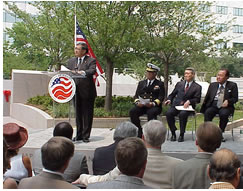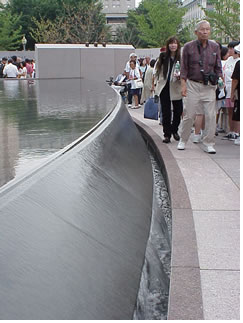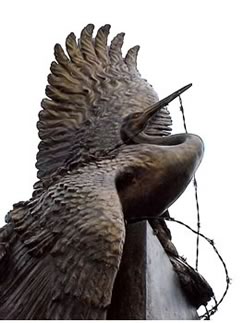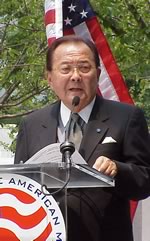

Associate Editor
 Prominent
members of the Japanese American community officially opened the National
Japanese American Memorial June 29 in Washington, D.C. The new national
monument, designed by Davis Buckley Architects and Planners, honors Japanese
Americans during World War II, both those who fought overseas and the
thousands of civilians who were placed in internment camps.
Prominent
members of the Japanese American community officially opened the National
Japanese American Memorial June 29 in Washington, D.C. The new national
monument, designed by Davis Buckley Architects and Planners, honors Japanese
Americans during World War II, both those who fought overseas and the
thousands of civilians who were placed in internment camps.
U.S. Congressman Robert Matsui (D-Calif.) (seated, center) served as master
of ceremonies. Senator Daniel K. Inouye (D-Hawaii) (seated, right), Rear
Admiral Melvin Chiogioji, Ret. (seated, left), and Transportation Secretary
Norman Y. Mineta (speaking) were among the American officials with Japanese
heritage who participated in the ribbon-cutting ceremony.
Mineta and his family were among 120,000 Americans
of Japanese ancestry forced from their homes and into internment camps
during World War II. After graduating from the University of California
at Berkeley, Mineta joined the Army in 1953 and served as an intelligence
officer in Japan and Korea. Inouye was a Captain in the U.S. Army and
was badly injured during World War II. He was awarded with the Medal of
Honor, the nation's highest award for military valor, as well as the Distinguished
Service Cross, Bronze Star, and Purple Heart.
"Arriving at this day has taken great leadership," Mineta said.
"The leadership of dedicated citizens…the memorial foundation
. . . and the support of people across the country."
 The
memorial "speaks to the injustice of the evacuation, the sacrifice
of the people of Japanese-American descent made for this country, the
redemption of faith in our country, and the journey from injustice to
understanding," Mineta concluded.
The
memorial "speaks to the injustice of the evacuation, the sacrifice
of the people of Japanese-American descent made for this country, the
redemption of faith in our country, and the journey from injustice to
understanding," Mineta concluded.
The memorial is on a triangular piece of land, just north of the U.S. Capitol. The 33,000-square-foot park and plaza features water, sculptural, and contemplative elements that focus on the evacuation and internment of Japanese Americans, and the denial of their civil rights without due process. It also reflects the patriotism and sacrifices of those who served the country faithfully during World War II.
Matsui acknowledged Architect Buckley and his staff for their commitment to the project, and noted that he worked without compensation prior to being selected as the leading designer for the memorial.
Buckley said the response to the memorial has been very positive. He said he found the experience, "deeply emotional," especially because he was working with members of the Japanese American community who put in him a great trust. The memorial, Buckley said, "is a testament to our country's ability to right our wrongs and remind people of the importance of our civil liberties."
 The
central piece of the memorial is a bronze sculpture of two cranes struggling
to break their barbed-wire bonds. In Japan, cranes symbolize happiness,
good fortune, and longevity. The cranes were designed by American Nina
Akamu, whose grandfather died in one of the internment camps. Her father
served in the U.S. Air Force. Akamu told the Washington Post that she
"wound barbed wire about the birds' wings . . . to capture the paradox
of freedom and oppression in her family's history and that of her own
community."
The
central piece of the memorial is a bronze sculpture of two cranes struggling
to break their barbed-wire bonds. In Japan, cranes symbolize happiness,
good fortune, and longevity. The cranes were designed by American Nina
Akamu, whose grandfather died in one of the internment camps. Her father
served in the U.S. Air Force. Akamu told the Washington Post that she
"wound barbed wire about the birds' wings . . . to capture the paradox
of freedom and oppression in her family's history and that of her own
community."
The names of 10 internment camps, where 120,000 Japanese Americans were held for up to four years, are etched into one wall of the memorial, and the names of more than 800 Japanese-Americans killed in combat are engraved in another. The park also features rocks in a reflecting pool of moving water that represent the islands of Japan and the generations of Japanese-Americans who struggled through this difficult time in our nation's history.
An interactive bronze bell created by Paul Matisse, grandson of French painter Henri Matisse, was also unveiled.
Copyright 2001 The American Institute of Architects. All rights reserved.
![]()
|
Senator Daniel K. Inouye (D-Hawaii) spoke about his World War II experience.
Photos by M. David Williams. |
|
